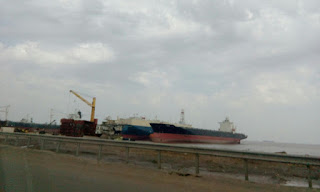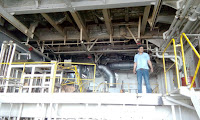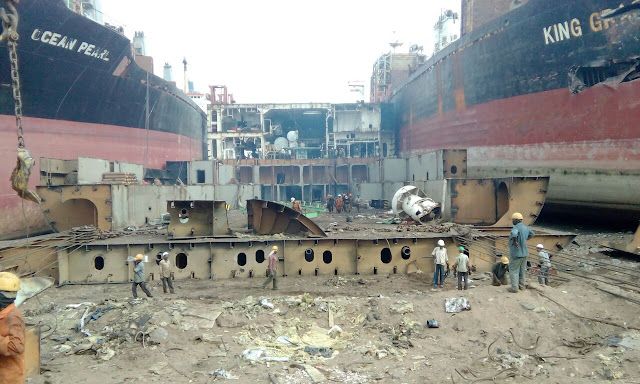Thursday, March 24, 2016
Alang; a porthole onshore.
The permanent stains of oil and grease on my leather shoes is a souvenir I brought back from Alang.
My frequent travel to Gujarat in the recent past enlightened me about Alang on the western coast of the Gulf of Khambat. Considered to be one of the world's largest shipyards, Alang recycles half of world's ships.
The swirl of the windmills while approaching the shore, the moisture laden winds and a drizzle followed by a strong sun was all that was essential to make this brief visit drenched in filth and dirt. Dirty in real sense, beautiful in a realistic sense. Apparently, Alang is one such evident example of business tourism in India where one encounters cargo ships, containers, passenger ships, cruises that approach this shore for their final breakdown bringing along people from Korea (of course South), Japan, Europe, South East Asia and locally from all parts of India. I hence spotted lesser Gujratis in Gujarat. Loads of young men from Bihar and UP are here making this place sound very different to how Gujarat sounds. A sea shore for someone who comes from a landlocked area of India's National capital is typically a beach in Kerala or a shack in Goan waters but this was a third dimension. A shore with Ships of all sizes lined, fumes in the air of continuous welding and burning, moisture of the western coast and noise of course from all the dismantling happening around. One of the workers took me to this cargo which was a live example for me.
As a practicing spatial designer I couldn't stop myself from admiring the fact that the best possible way to see efficient space planning is to get into a ship. And if its a ship getting dismantled, its a blessing indeed! You not only visually observe a sectional elevation of this massive structure being chopped off in parts but you even practically experience it finding yourself standing at one of the levels.
Climbing to the third level from the deck using the technically called 'bulwark ladder', I found myself in some machine room which was not a room. Actually, I was inside the engine which was now half opened! Felt as an anti body inside the engine of an automobile. Like how they show in automobile engine oil animated graphic ads with the gear starts moving at a faster pace when poured the special engine oil.
Further up, there was this part which seemed to be a habitable part of a cargo ship. My attention was grabbed by this plant which was still alive in a ship, breaking of which had started 2 months back.
About the materials and stuff gathered from any ship, there is a different chapter to the story. There are merchants who deal in specific stuff and leftover. So you have one trader who deals only in reclaimed wood and you end up getting good quality wood that has survived at least 20 years in the global ocean waters and then you have series of shops selling machinery that is further purchased by mechanics, industrial design students and small scale industries. From toilet paper to computers, electricals to old paintings, anchors to bunk beds, life jackets to Jack Daniel glass ware. You get everything here for your next startup!
And heres a mere flowchart of how transportation and businesses happen that I had learnt in school books.
This visit was one of those unplanned ones that strengthen my ideology that travel can never be planned. The perception of travel in this age of DSLRs has to be instant. Any location can be beautiful, charming and picturesque.
With a time restriction, it was time for me to head North and catch the last flight of the day to Delhi.
Taking back home not just the oil stains and soiled denims from Alang, I did managed to trade an age old compass from one of the shops selling antiques which I don't think I am ever going to use pertaining to my 'rolling Stone, no direction home ideology'
Labels:
Alang,
Bhavanagar Gujarat,
Gujarat,
Ship,
Shipyard
Subscribe to:
Posts (Atom)












